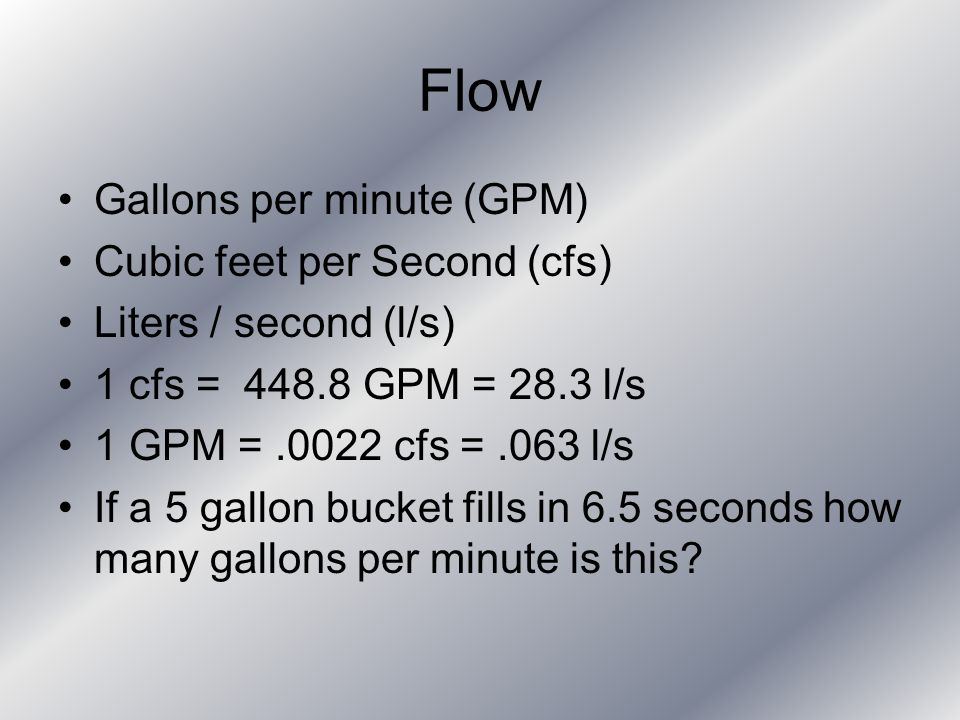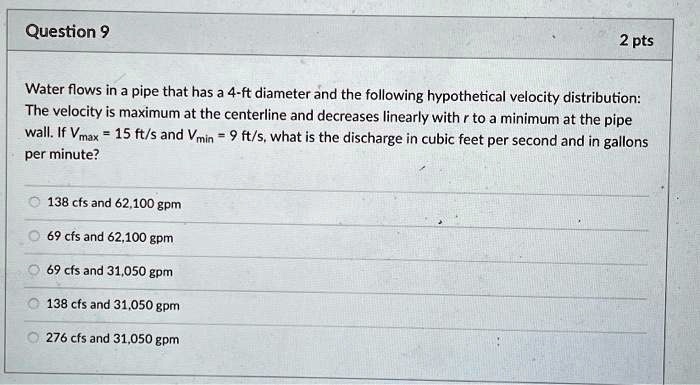
How many gallons per minute are in a acre foot?ġ acre foot per year (acre-ft/yr) = 0.62 gallons US per minute (gal/min) * 1 cfs is equivalent to 448.8 gallons of water flowing per minute. * 1 cfs = 1.983 acre-feet per day = 646,320 gallons = 2447 cubic meters of water. * 1 cubic foot per second = 7.4805 gallons flowing by a particular point in 1 second. How many gallons is 1 CFS?Ĭubic feet per second (cfs): * 1 cubic foot = 7.4805 gallons. 1 cfs is = to 7.48 gallons per second, 448.8 gallons per minute, 646,272 gallons per day and 1.98 acre-feet per day. One “cfs” is equal to 7.48 gallons of water flowing each second. It is equal to a volume of water one foot high and one foot wide flowing a distance of one foot in one second.
#CFS TO GPM FREE#
Take a few extra measurements, and then average those measurements.įeel free to call us at (435) 755-0774 if you have questions.Please share if you found this tool useful: Conversions Tableġ Cubic Feet Per Second to Gallons (us Fluid) Per Second = 7.4805ħ0 Cubic Feet Per Second to Gallons (us Fluid) Per Second = 523.6364 Tip: To improve accuracy in very wide channels you can take more velocity readings by dropping the float in different locations across the width of the channel. 85 you will get 1.7 ft/s, this will most likely be a better value to use in your flow calculation for the overall discharge rate. For example, if your surface velocity measurement is 2 ft/s (feet per second) and you multiply that by.

85, to adjust the overall velocity to be more representative of the slower velocities under the surface. To account for this, we take the surface velocity measured, and multiply it by. NOTE: Surface velocities are typically higher than average overall channel velocity. New Estimated CFS – 4.86 Area x 1.87 ft/s = 9.136 CFS 85 = 1.87 adjusted ft/s (feet per second) If my float measurements gave me an average surface velocity of 2.2 ft/s (feet per second), then I can calculate the CFS discharge by using the discharge formula below.ĬFS = 10.69 (Cubic Feet per Second) or CFS x 448.83 = 4,797.99 GPM (converted CFS to GPM)Īdjusted Velocity (see note below) = 2.2 ft/s x. Now you can take the channel width (let’s say 6 feet) and multiply that by the average depth. 81 – this is the average depth across the channel. See example below: Depth 1Īdd up the depth values to get 8.1 and divide that by the number 10 (10 is how many measurements were made) the value you get is. Try to take these depth readings about every 1 foot across (depending on the width and uniformity of the channel).Īfter taking the depth readings you simply add up the depths and divide that number by how many depth readings you measured. To get an overall channel area measurement, simply measure the width of the channel and then take 10 or more depth readings across the width.

Taking ten depth measurements is the recommended minimum required but more will be better, especially in larger channels (about every foot across). Use a yard stick or staff gauge to measure the depth at regular intervals across the channel. Be sure it is safe to wade, before getting in the channel. Measure stream’s width and depth across the downstream marker section. You should repeat the measurement at least 3 times and use the average feet per second by adding the three measurements and dividing that number by 3. Start the timer when the object crosses the upstream marker and stop the timer when it crosses the downstream marker. Step 3. Throw your floating object into the stream upstream of your upstream marker. The faster the velocity the harder it is to time the travel over short distances. We recommend 20 feet as a minimum, but a travel time of around 20 seconds is best.

Mark the beginning and end of the distance your floating object will travel. Choose a suitable channel section with minimum turbulence (ideally at least 3 channel widths long). V (Velocity) = Distance Traveled / Time to travel (feet traveled divided by seconds) We recommend doing these calculations in Feet and Seconds for convenience in converting to CFS (Cubic Feet Per/Second flow rate).ĬFS = A x V (area multiplied by velocity)Ī (Area) = Width of Channel (feet) x Depth of Water (feet)


 0 kommentar(er)
0 kommentar(er)
